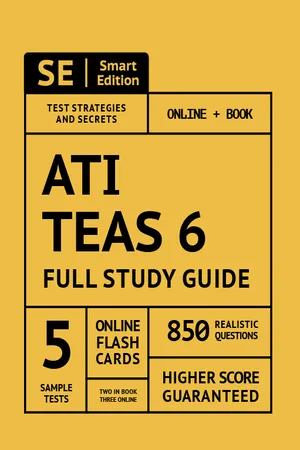
- English
- ePUB (mobile friendly)
- Available on iOS & Android
About This Book
The Smart Edition ATI TEAS 6 Study Guide was designed to offer significantly more value than any other study guide on the market. We work hard to provide you with the highest quality test prep materials at an affordable price. We sincerely hope we earn your trust to help you prepare for your exam. Don't pay the same or more for a study guide that offers you fewer resources than Smart Edition.
This is the ONLY study guide on the market that contains:
- 5 full-length practice tests
- 850 realistic test questions
- Online flashcards.
Practice Tests
One of the best ways to prepare for the ATI TEAS 6 exam is to spend as much time as possible practicing test questions. Most study guide options offer 2 exams, maybe 3, but no other study guide offers you 5 full-length practice exams. You will find 2 practice tests in the book and an additional 3 tests online. Our online tests can be taken an unlimited number of times while some competitors only let you take the test once.
- 2 Practice Tests In The Book
- 3 Practice Tests Online
- Answer explanations broken down by skill within the subject area
- Easily identify your strengths and weaknesses
- Tests can be taken an unlimited number of times
- Full answer explanation to help you understand why each answer is correct
-
?
Online Flashcards and games
Flashcards are included in your purchase and offer a great way to learn and memorize key terms, vocabulary, and definitions. One of the most difficult subjects on the TEAS exam is Anatomy and Physiology. We provide you with 300 flashcards on 10 A&P systems, giving you the best possible chance to master this difficult section of the exam. The flashcards also offer games including the memorization game, quiz game, matching game, and the gravity game. It basically makes learning fun so you forget your studying for a major exam for just a few minutes: ) Trust us, you'll like it.
- 500 Flashcards covering all subjects
- 300 flashcards on Anatomy and Physiology covering 10 A&P systems
Study Content
Smart Edition ATI TEAS 6 study guide covers all subject areas tested on the exam and is designed to be a concise review for everything you will need to know. You will find that our study guide is not page after page of heavy text, rather we break up our content in many ways with images, illustrations, step by step breakdowns, charts, graphs, tables, and tips and tricks.
- English language arts
- Science
- Math
- Reading
Frequently asked questions
Information


Table of contents
- Introduction
- How to Use This Book
- Section I Reading
- Chapter 1 Key Ideas and Details
- Main Ideas, Topic Sentences, and Supporting Details
- Summarizing Text and Using Text Features
- Practice Quiz 1
- Chapter 2 Craft and Structure
- Tone, Mood, and Transition Words
- The Author’s Purpose and Point of View
- Evaluating and Integrating Data
- Practice Quiz 1
- Chapter 3 Integration of Knowledge and Ideas
- Facts, Opinions, and Evaluating an Argument
- Understanding Primary Sources, Making Inferences, and Drawing Conclusions
- Types of Passages, Text Structures, Genre and Theme
- Practice Quiz 1
- Section II Mathematics
- Chapter 4 Numbers and Basic Operations
- Basic Addition and Subtraction
- Basic Multiplication and Division
- Decimals and Fractions
- Multiplication and Division of Fractions
- Ratios, Proportions, and Percentages
- Practice Quiz 1
- Chapter 5 Algebra
- Equations with One Variable
- Equations with Two Variables
- Solving Real-World Mathematical Problems
- Powers, Exponents, Roots, and Radicals
- Polynomials
- Practice Quiz 1
- Chapter 6 Measurement and Data
- Standards of Measure
- Interpreting Graphics
- Similarity, Right Triangles, and Trigonometry
- Circles
- Practice Quiz 1
- Section III Science
- Chapter 7 Human Anatomy and Physiology: Organization of Systems
- Organization of the Human Body
- The Cardiovascular System
- The Respiratory System
- The Gastrointestinal System
- The Reproductive System
- The Urinary System
- Practice Quiz 1
- Chapter 8 Human Anatomy and Physiology: Support and Movement
- The Skeletal System
- The Muscular System
- The Integumentary System
- Practice Quiz 1
- Chapter 9 Human Anatomy and Physiology: Integration and Control
- The Nervous System
- The Endocrine System
- The Lymphatic System
- Practice Quiz 1
- Chapter 10 Life and Physical Sciences
- An Introduction to Biology
- Cell Structure, Function, and Type
- Cellular Reproduction, Cellular Respiration, and Photosynthesis
- Genetics and DNA
- Practice Quiz 1
- Chapter 11 Scientific Reasoning
- Designing an Experiment
- Scientific Notation
- Temperature and the Metric System
- Practice Quiz 1
- Section IV English Language and Usage
- Chapter 12 Conventions of Standard English
- Spelling
- Capitalization
- Punctuation
- Practice Quiz 1
- Chapter 13 Parts of Speech
- Nouns
- Pronouns
- Adjectives and Adverbs
- Conjunctions and Prepositions
- Verbs and Verb Tenses
- Practice Quiz 1
- Chapter 14 Knowledge of Language
- Subject and Verb Agreement
- Types of Sentences
- Types of Clauses
- Formal and Informal Language
- Practice Quiz 1
- Chapter 15 Vocabulary Acquisition
- Root Words, Prefixes, and Suffixes
- Context Clues and Multiple Meaning Words
- Practice Quiz 1
- Section V Full-Length Practice Exams
- TEAS Practice Exam 1
- Section I. Reading
- Section II. Mathematics
- Section III. Science
- Section IV. English and Language Usage
- Answer Key with Explanatory Answers
- TEAS Practice Exam 2
- Section I. Reading
- Section II. Mathematics
- Section III. Science
- Section IV. English and Language Usage
- Answer Key with Explanatory Answers